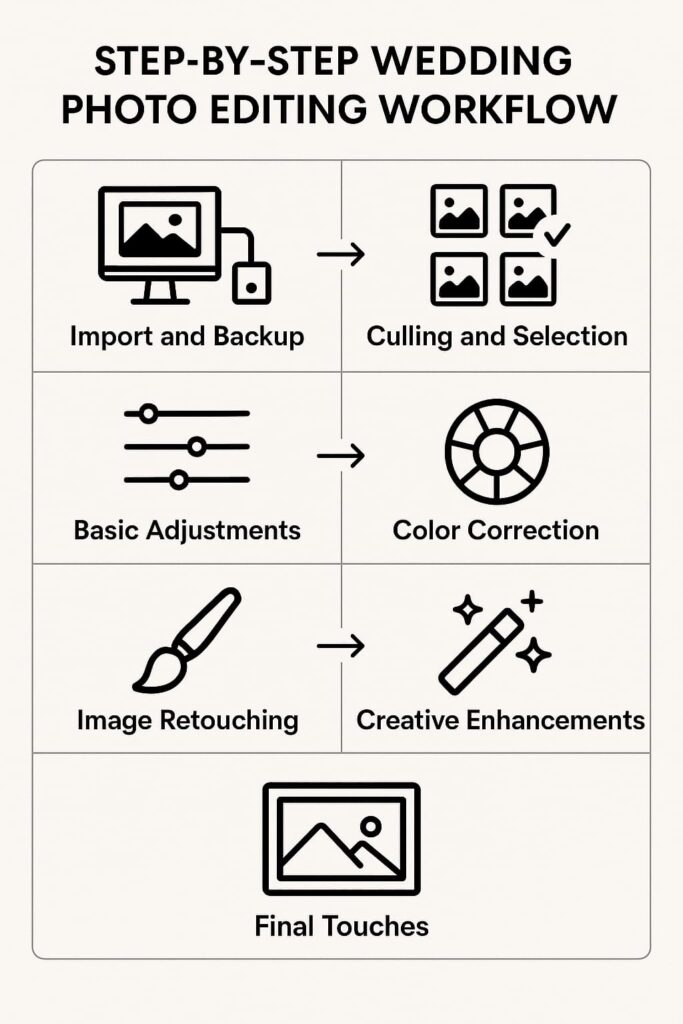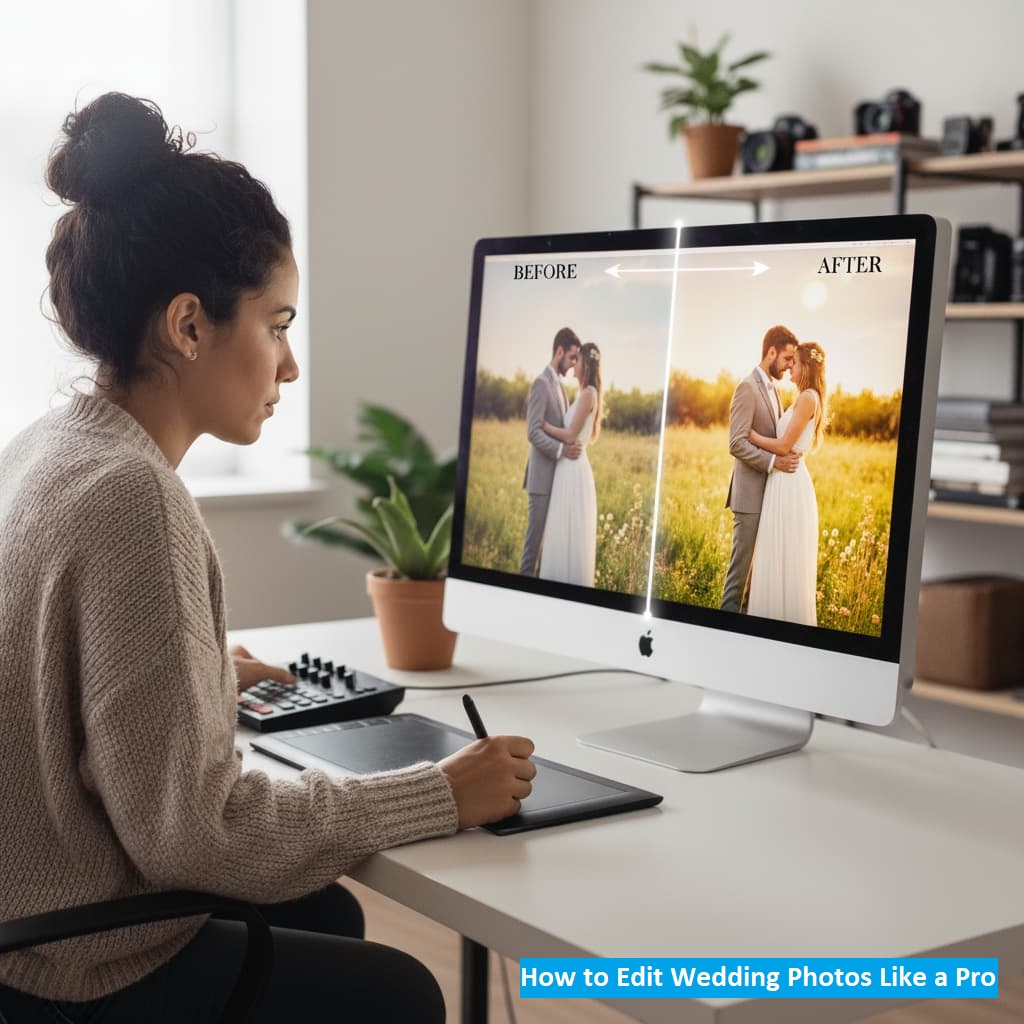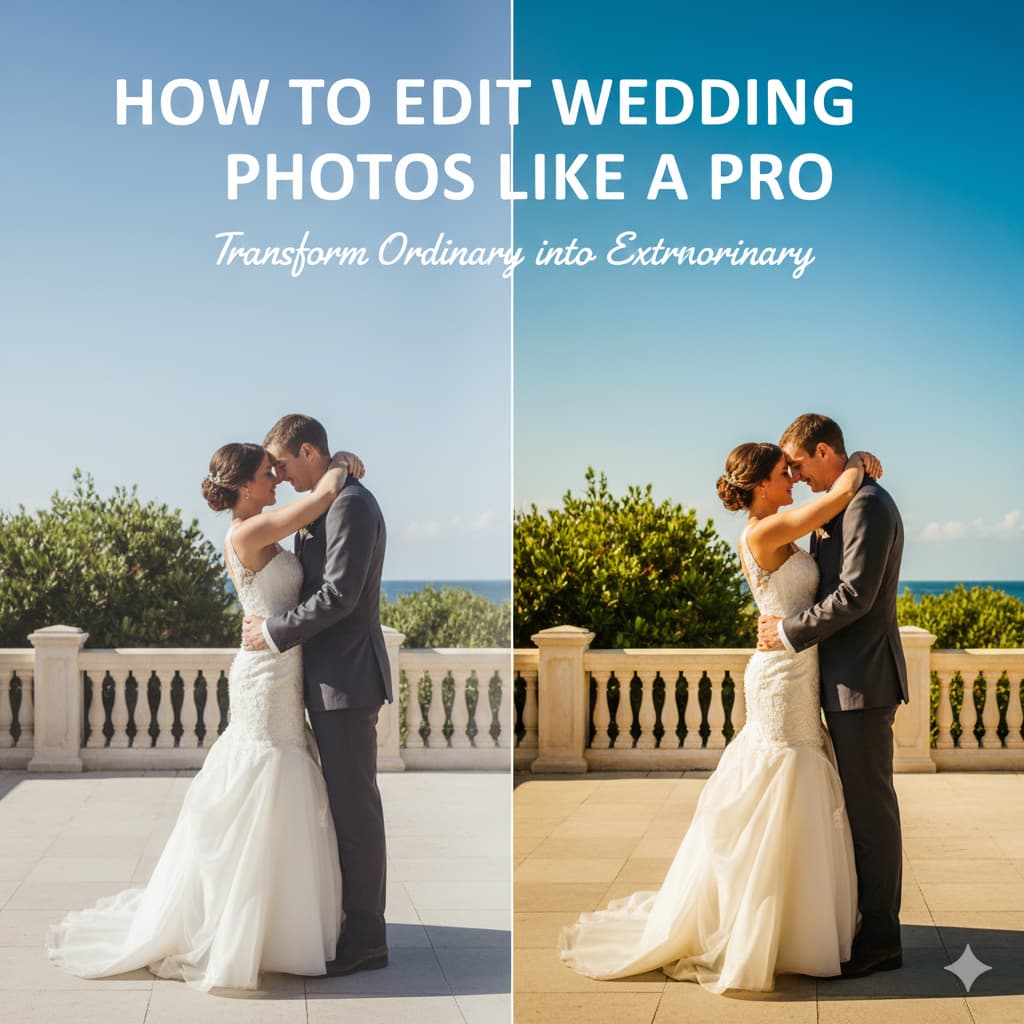Wedding photos capture a couple’s special day, and editing them well is crucial for making those memories last. Wedding photo editing helps bring out the best in your images and gives them a professional touch. If you’re a beginner or an experienced photographer, this guide will help you edit wedding photos like a pro.
Essential Tools for Wedding Photo Editing
To edit wedding photos like a pro, you’ll need the right tools. Here are the best options:
1. Adobe Lightroom
Lightroom is great for batch editing. It allows you to adjust exposure, color, and contrast in a fast and efficient way. You can also apply presets for consistency.
- Batch editing: Edit multiple photos at once.
- Color correction: Adjust white balance and tones.
- Presets: Use presets for a uniform style.
2. Adobe Photoshop
Photoshop is perfect for detailed editing. It lets you fix imperfections, remove distractions, and work with layers for advanced edits.
- Retouching: Smooth skin, remove blemishes, and enhance details.
- Object removal: Remove unwanted objects from your photos.
3. Capture One
Capture One is great for studio photography. It’s known for its color grading tools and precision.
- Color grading: Get the perfect tones for every photo.
- Tethered shooting: Take photos directly to your computer.
4. AI-Powered Tools
AI tools like Luminar Neo speed up editing. They automatically adjust exposure, colors, and details, making editing quicker and easier.
- Quick edits: AI tools adjust your photos in seconds.
Step-by-Step Wedding Photo Editing Workflow

Here’s a simple workflow to help you edit wedding photos from start to finish.
1. Import and Backup
First, import your RAW files into your editing software. It’s also important to back up your photos. Use the 3-2-1 strategy: three copies of your files, two stored in different locations, and one off-site backup.
2. Culling and Selection
Go through your photos and choose the best ones. Use software like Photo Mechanic or Lightroom to help you pick the images that tell the best story.
- Look for emotion: Choose photos that capture important moments.
- Quality over quantity: Less is more focus on the best photos.
3. Basic Adjustments
Start by adjusting exposure, white balance, and contrast. These are the basics for getting a clean, well-lit image.
- Exposure: Adjust brightness or darkness.
- White balance: Fix any warm or cool color tones.
- Contrast: Increase contrast to make the image pop.
4. Color Correction
Next, correct the colors. You want your images to look natural, with accurate skin tones and a balanced color palette.
- White balance: Fine-tune the white balance for realistic colors.
- HSL (Hue, Saturation, Luminance): Adjust individual colors for a balanced look.
5. Image Retouching
Wedding photos often need retouching to remove blemishes and imperfections. Use Lightroom or Photoshop for these detailed edits.
- Skin smoothing: Use the healing brush tool to smooth skin without making it look too artificial.
- Blemish removal: Remove any unwanted marks or spots.
6. Creative Enhancements
Now, you can add your creative touch. This can include applying presets, adding vignettes, or using gradients to enhance the mood.
- Presets: Apply a preset to give all your photos a consistent look.
- Textures: Add a soft texture or gradient to give your photos a unique feel.
7. Final Touches
Before you export, make the final adjustments:
- Sharpening: Sharpen your images to bring out the details.
- Noise reduction: If your photos are grainy, reduce the noise for a cleaner look.
Popular Wedding Photo Styles
Different couples like different looks. Here are some common image editing styles:
- Light and Airy: Bright, soft, and romantic. Perfect for outdoor weddings.
- Dark and Moody: Deep shadows and dramatic colors. Works well for rustic or evening weddings.
- Classic Film Look: Warm tones and a timeless feel.
- Vintage: Faded colors with a soft, old-style look.
- Black and White: Simple, emotional, and powerful.
Choose a style that matches the couple’s personality and the wedding mood.
Common Mistakes to Avoid
While editing, there are a few common mistakes you’ll want to avoid:
1. Over-Editing
It’s easy to get carried away with editing, but too much can make your photos look unnatural.
- Don’t over-smooth skin: Keep skin textures realistic.
- Avoid oversaturation: Keep colors balanced and natural.
2. Inconsistent Image Editing
Make sure your photos look consistent. If you edit one photo heavily and leave others untouched, the final set can feel disjointed.
- Use presets: Applying the same preset to all your photos will keep the style consistent.
3. Ignoring Client Preferences
Always talk to your clients about their preferences. Some may want light and airy photos, while others may prefer dark and moody tones.
- Customize your edits: Tailor your editing style to match the couple’s vision.
Why Do You Need Retouching in Professional Wedding Photo Editing?

Photo retouching makes your wedding pictures look clean, bright, and beautiful. Here are the main reasons it is needed:
- Fixes small flaws like spots, blemishes, or stray hair.
- Makes skin look smooth and natural.
- Adjusts light and colors so photos look bright and balanced.
- Brings out details in the dress, décor, and background.
- Keeps the natural look while making the photo more polished.
- Turns simple photos into lasting memories you’ll love to keep.
With professional wedding photo retouching, every photo can show the true beauty of your big day.
Tips to Save Time While Photo Editing for Weddings
Editing takes hours, but you can work smarter:
- Use star ratings or color labels in Lightroom to sort photos faster.
- Learn a few keyboard shortcuts to speed up your work.
- Edit one photo, then copy the settings to others with similar lighting.
- Create your own presets so you can use them again in the future.
Conclusion
Wedding photo editing is an essential skill for photographers. By following this simple workflow and using the right tools, you can turn raw photos into beautiful, professional memories. Whether you’re using Lightroom, Photoshop, or AI tools, these editing tips will help you get the best results for your clients.
FAQ
1. How long does it take to edit a wedding?
It can take anywhere from 10 to 20 hours to edit a wedding, depending on the number of photos and how detailed the edits are.
2. Can I edit wedding photos without professional software?
Yes! There are free tools like GIMP, Pixlr, and Fotor that offer basic editing features. They might not have all the advanced tools, but they can get the job done.
3. What are the best editing styles for wedding photos?
Popular styles include Light and Airy, Dark and Moody, and Vintage. Each style brings out different emotions, so choose one that fits the couple’s personality.
4. How do I ensure my edits are consistent?
To keep your edits consistent, use presets and adjust each photo in the same way. This helps maintain a uniform style across all images.


